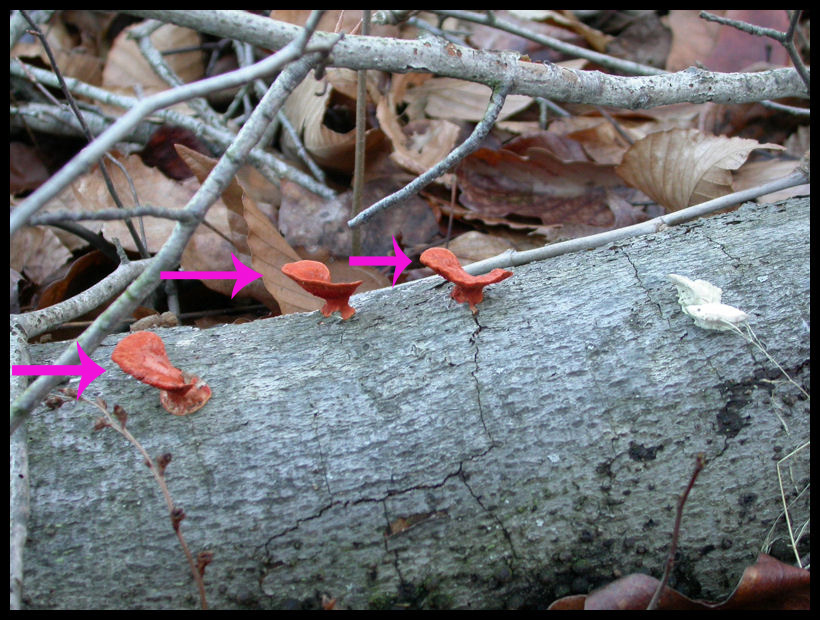 Pycnoporus
cinnabarinus - Although common names are not that useful for a lot
of the fungi, you might see this one listed as the "Cinnabar red polypore".
It is really the only one that looks that bright and that shade of red when
fresh. As they dry, they can get more tan and even brown in color.
Pycnoporus
cinnabarinus - Although common names are not that useful for a lot
of the fungi, you might see this one listed as the "Cinnabar red polypore".
It is really the only one that looks that bright and that shade of red when
fresh. As they dry, they can get more tan and even brown in color.
Photo: Arrows point to the fungus fruiting bodies of on
symplastless American Beech wood. Picture was taken on 1-18-2005 in
Maryland, USA.
Because the fertile, spore-bearing surface contains lots of pores and the
fungus does not have much of a stipe or "stem", old-timers would put it in
the genus "Polyporus". Over the last hundred years, taxonomists have
recognized that lumping all fungi that have pores and little or no stipe
results in putting together some pretty unrelated fungi. So,
mycologists have set up "segregate genera" to break up the huge old and
heterogeneous genera into smaller genera that make more sense, from the
point of view of natural relatedness. So before complaining about
"Pycnoporus" being a new name, recognize that this name was coined in the
1890's!
"Pycnoporus" means "with small, dense pores". Cinnabar is a bright red
mineral. It's a pretty descriptive name!
And, the Cinnabar polypore is usually found on
symplastless wood of deciduous
trees, but can be rarely found on pines as well.
This fungus details and identification was provided by
Kevin T. Smith, Ph.D.
Dictionary MAIN
PAGE
Text & Graphics Copyright © 2008
Keslick & Son Modern Arboriculture
Please report web site problems, comments and words of interest,
not found.
Contact
 Pycnoporus
cinnabarinus - Although common names are not that useful for a lot
of the fungi, you might see this one listed as the "Cinnabar red polypore".
It is really the only one that looks that bright and that shade of red when
fresh. As they dry, they can get more tan and even brown in color.
Pycnoporus
cinnabarinus - Although common names are not that useful for a lot
of the fungi, you might see this one listed as the "Cinnabar red polypore".
It is really the only one that looks that bright and that shade of red when
fresh. As they dry, they can get more tan and even brown in color.